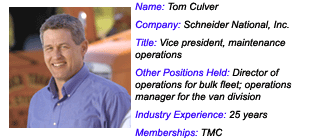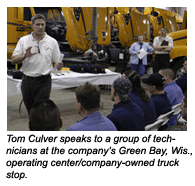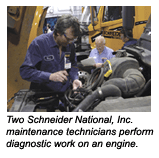Schneider National’s Tom Culver says open communications, training and shared knowledge draw technicians closer to the business.

Managing the activities and operations of 620 technicians and keeping them motivated, trained and productive is a staggering responsibility. Especially when they are scattered across 30 shops in North America in a decentralized operating environment.
But Schneider National, Inc. keeps its maintenance operation in high gear by treating its technicians openly and honestly and giving them a voice in their daily duties so they don’t feel like a small cog in a big machine, according to Tom Culver, vice president, maintenance operations.
“We want open, two-way communications between technicians and all managers,” Culver says. “One way we do this is to make sure our shop leaders are very visible by being on the floor for the majority of the day. They are involved with service coordination and decision-making on the floor.”
The company also conducts weekly shop meetings to share business and technical information, such as current freight rates, financial results and specific maintenance issues.
“We feel that the more knowledge we give them, the more current they are in terms of our business and customer challenges,” he says. “It enlightens them and engages them in the business.”
Engaging technicians in the business is important to the success of the Green Bay, Wis.-based business, which has 15,500 drivers, 48,000 trailers and 11,000 company-owned power units.

Each of the 30 shops also has a systems champion for major categories, such as engines, air conditioning, tires, trailers and electrical, who participates in a monthly conference call among all the shops. It could be about diagnostic repairs, new technology or issues on the shop floor.
“Conference calls are a great way to engage all 30 shops in two-way communications,” Culver says. “They have a defined agenda and stick to critical issues so they don’t get off track. We want this to be participatory, not driven from the top, because they are addressing issues that exist in the shops. It is a powerful tool.”
Another communications program is a formal quality improvement process that collects and recognizes ideas from the shop floor.
“We encourage associates to submit ideas for improvements in tooling and diagnostics,” he says. “We’ll review them and if they have value, their ideas are tested at other locations, and they can become best practices. We want to foster an environment of continuous improvement.”
Training
The company’s training program consists of four elements. The first is safety and compliance, which addresses OSHA and DOT issues and the company’s core values. These are conducted annually and much of it is Web-based so it can be conveniently offered when needed.

Proficiency training is addressed by courses designed to address specific job needs of an individual or shop. This training enhances associates’ skills to meet specific requirements.
“If we see a trend or recognize a need, we will send a company trainer to select shops,” Culver says. “Needs are based on performance vs. measured expectations.”
The third component is new equipment training. This focuses on component theory, function and diagnostics. Most equipment training is done through internal resources. The final part is professional development, which is more individually based.
“When we hire new mechanics we’ll train them on our methodology,” he says. “There also are remedial modules. Some mechanics participate in our teacher future mechanic development program, which is 50 percent on the job and the rest on their own time. This often requires work on more select systems.”
The company’s leadership foundation program is for shop associates who aspire to be leaders, and some of that is done on their own time. The company has one full-time training manager and five part-time trainers who are shop associates who are systems experts at various locations.
Keeping technicians starts with a compensation package that is “very competitive” in the local market, Culver says. But it doesn’t stop there.
“Our shops are nice, clean, well-lit and well-tooled,” he says. “We believe that our culture of engagement and participation helps retain technicians. We enjoy getting their input and we go out of our way to treat them fairly. We want them to feel they are an important part of the organization.”
When it’s time to hire technicians, recruiting is done locally.
“We have relationships with schools in various markets, and many of our hires are from referrals from current employees. Some areas are more difficult than others to hire technicians. We have a good reputation on how we treat our people, so that helps.”
The company believes in promoting from within and relies on its future leader development program to prepare associates to move from the shop into a management position, such as maintenance team leader.
“About 35 percent of our team leaders were techs,” Culver says. “The next step may require a move.”
